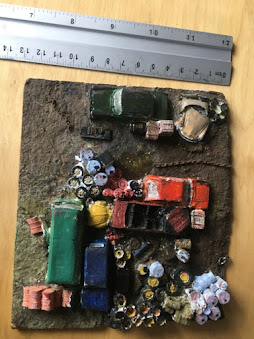I’ve started work on sourcing and painting up some scenic elements and terrain for the 15mm Terminator project, and am kicking things off with some wrecked cars and a suitably scrappy junkyard.
I’ve found that 15mm vehicles in a pristine state can be fairly expensive to buy, given that in the Post-Apocalyptic wilderness they will be just heaps of rust - so have resorted to utilising some HO/OO scale railway pieces as stand-ins; I think they measure up pretty well alongside 15mm minis as depicted here.
That said, some Railway Model scenics can be pretty pricey too, so I was happy to be able to get hold of these simple plastic HO chassis types, made by Jouef in France, via an EBay joblot. No bells or whistles here, just the shape of the car and some plain generic wheels:
There are no interiors or windscreens, but as I was about to commit grievous bodily harm on them anyway, there were no worries about prior disassembly, masking or other details, just needed to give them a suitably grizzled rusty blitz over the original colour:
These should look good populating the ravaged streets of an urban area after The Fall, and being basic plastic, might also lend themselves to being cut-up or ‘crushed’ by chopping down the roof supports etc, so could become part of larger scenic elements for the Terminators to hunt in….talking of scenics, lets move onto the aforementioned junkyard:
This is a large all-in-one resin piece for Railway Modelling that again, I was lucky enough to dig out from EBay, and had been provided with a basic paint-job by the previous owner:
Not to get too precious or artsy-fartsy about paint Triads, but I found the following from Vallejo’s Game Effects ranges to be definitely up to the job:
Throwing in the HO scale car wrecks, and some water puddles splashed on by the simple expedient of squirting the last drops out of an old bottle of plastic cement, got me to here:
Not looking too shabby, or rather, should I say, as intended, definitely looking shabby !
I think the junkyard will benefit from having some perimeter walling or gates added, so I will likely base it on some plasticard or similar to give it some edges to work from, and then let it sit neatly into a wider urban setting.
I’ve just realised that the one mini I didn’t put out for the photo session was the actual ‘Junkyard’ dog that I painted last time - but I’m sure he’ll get the opportunity to try it out eventually….
I feel that beyond Terminator, the piece could be used for other settings too - it occurs to me that there is something green and nasty leaking out of those military-grade barrels in the lower left corner…. Looks like a zombie spawning ground if I ever saw one……
Anyway, wonderful British Summer Weather permitting, I’m planning an outdoor session of spraying lots and lots of MDF with acrylic sealant, prior to painting, so stay tuned for some Post-Apocalyptic town planning soon !























































